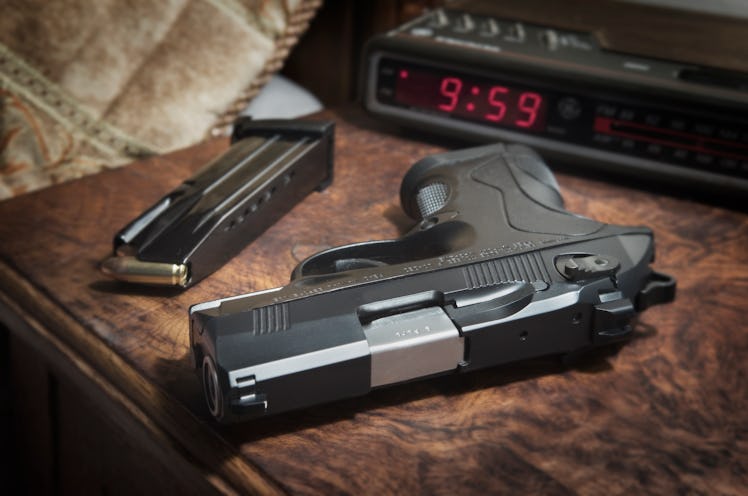The One Thing Experts Agree On When It Comes To Guns And Kids
New research is boon for parents looking to have the talk about gun safety.

In late November, an NBC News poll revealed that more than half of American voters either had a gun or knew someone in their household who had a gun — the highest level of gun ownership recorded since the poll began in 1999, up from 46% in 2019. With so many gun owners in the United States, the need for gun safety education — and in particular education around safe gun and ammunition storage — is paramount. Troublingly, a separate and recent survey of gun owners found that many of those gun owners see little value in storing weapons securely, countering one of the primary safety tips for lowering accidental gun violence — especially among kids — at a time of record-high gun-ownership. For parents sending their kids over to the houses of their friends, these two facts are on a parallel track of safety that warrants legitimate concern.
The new study from the New Jersey Gun Violence Research Center at Rutgers University and published in the journal Suicide and Life-Threatening Behavior collected a representative sample of 941 gun owners from five diverse states last year. Nearly a quarter of the respondents from New Jersey, Minnesota, Mississippi, Colorado, and Texas indicated they typically store at least one firearm loaded and unlocked and see less value in specific firearm storage methods than those who store guns securely.
“If firearm owners are unaware of the suicide prevention value of secure firearm storage practices, it makes sense that they opt to have at least one firearm in their home stored loaded and unlocked,” Michael Anestis, executive director of the New Jersey Gun Violence Research Center at Rutgers and lead author of the study said in a release. “The problem is, staging a firearm so it is so quickly accessible dramatically increases the risk for injury and death, so these perceptions are causing firearm owners to put themselves and their families in danger.”
The firearms owners are making unnecessarily risky choices about gun security based on erroneous cost-benefit calculations. They see their findings as consistent with the notion that many firearm owners don’t perceive suicide, unintentional shootings, or theft as likely occurrences in their own homes. But to whatever extent that is true for individual gun owners, those risks remain higher than the threat of an armed home invasion.
“The risk for armed home invasion requiring defense with a firearm is not zero, but it is lower than the risk of suicide and unintentional shootings,” Anestis said. “If firearm owners are misperceiving the risks associated with securely and unsecurely stored firearms, that means they are making important decisions for their homes and families based upon faulty information.”
Such miscalculations can carry grave consequences. As previously reported by Fatherly, guns are now the number one killer of kids in the United States. Suicide accounts for a significant share of gun deaths among kids. Between 2019 and 2021, gun deaths of minors increased by 50%.
The mounting research makes it clear that even parents who aren’t gun owners need to have conversations about gun safety with their kids. Doing so can play an important role in how they react if they come across an unsecured weapon, and can literally save their life. Earlier this year, Fatherly helped sound the alarm on the importance of firearm education for kids with reporting on a study that showed kids without gun education were far more reckless when stumbling across a firearm than kids who did receive gun education.
Kids don’t need to take a hunting course — but something akin to a firearm version of “stop, drop, roll” is a great addition to regularly reviewed family mantras. For example, Nemours Children’s Hospital suggests parents remind kids that when they come across a firearm to:
- Stop what they're doing.
- Do not touch the gun or allow anyone else to, even if it looks like a toy.
- Leave the area where the gun is.
- Tell an adult right away.
While talking to the parents of your children’s friends about gun safety can feel socially daunting, those conversations can help ensure you’re sending your child into safe environments. If straight-up asking whether or not they have a gun in the home seems too abrasive, Nemours suggests lower-friction entry points to the conversation like "My child is pretty curious. Is there a gun or anything else dangerous he might get into?" or "Our doctor recommended that I check to make sure there are no guns where my child plays. Do you have any guns at home?"
The American Academy of Pediatrics urges gun owners to lock unloaded firearms and store them out of reach and sight of kids. They also strongly recommend locking ammunition away in a separate location in the home. Previous reporting from Fatherly suggests that “the best advice is to buy a small biometric safe that only works with your fingerprint instead of one that uses a key or combination” and to invest in trigger locks for each gun.
Those interested in a free Project ChildSafe Safety Kit, which includes a cable-style gun lock and safety instructions, can check the organization’s directory of police departments offering kits in each state.